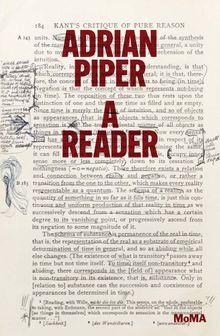| |||||||||||||||||||||||||||
CURATOR INDEX
|
|
in stock $45.00 Free Shipping UPS GROUND IN THE CONTINENTAL U.S. |
 Adrian Piper: A Synthesis of Intuitions 1965–2016
Adrian Piper: A Synthesis of Intuitions 1965–2016
Published by The Museum of Modern Art, New York.
Edited by Christophe Cherix, Cornelia Butler, and David Platzker. With texts by Christophe Cherix, Cornelia Butler, David Platzker, and Adrian Piper. Backmatter compiled by Tessa Ferreyros
Adrian Piper has consistently produced groundbreaking work that has profoundly shaped the form and content of conceptual art since the 1960s. Strongly inflected by her longstanding involvement with philosophy and yoga, her pioneering investigations into the political, social, psychological and spiritual potential of conceptual art have had an incalculable influence on artists working today.
Published in conjunction with the most comprehensive exhibition of her work to date, this catalog presents more than 280 artworks that encompass the full range of Piper’s mediums: works on paper, video, multimedia installation, performance, painting, sound and photo-texts. Essays by curators and scholars examine her extensive research into altered states of consciousness; the introduction of the Mythic Being—her subversive masculine alter-ego; her media and installation works from after 1980, which reveal and challenge stereotypes of race and gender; and the global conditions that illuminate the significance of her art. Previously unpublished texts by the artist lay out significant events in her personal history and her deeply felt ideas about the relationship between viewer and art object. This publication expands our understanding of the conceptual and post-conceptual art movements and Piper’s pivotal position among her peers and for later generations.
Adrian Piper (born 1948) is a first-generation conceptual artist and analytic philosopher. She received an AA in Fine Art from the School of Visual Arts in 1969, a BA in Philosophy with a minor in Medieval and Renaissance Musicology from the City College of New York in 1974 and a PhD in Philosophy from Harvard University in 1981. Piper’s artwork is in the collections of The Museum of Modern Art, the Centre Pompidou, the Metropolitan Museum of Art, the Generali Foundation and the Museum of Contemporary Art of Los Angeles, among others.
Cornelia Butler is Chief Curator at the Hammer Museum, Los Angeles.
David Platzker is Curator in the Department of Drawings and Prints at The Museum of Modern Art, New York.
Christophe Cherix is Chief Curator of Drawings and Prints at MoMA.
Tessa Ferreyros is Curatorial Assistant in the Department of Drawings and Prints at The Museum of Modern Art, New York.
PUBLISHER
The Museum of Modern Art, New York
BOOK FORMAT
Hardcover, 9.5 x 12 in. / 352 pgs / 373 color.
PUBLISHING STATUS
Pub Date 5/22/2018
Active
DISTRIBUTION
D.A.P. Exclusive
Catalog: SPRING 2018 p. 22
PRODUCT DETAILS
ISBN 9781633450493 TRADE
List Price: $65.00 CAD $87.00
AVAILABILITY
In stock
in stock $65.00 Free Shipping UPS GROUND IN THE CONTINENTAL U.S. |
 Lygia Clark: The Abandonment of Art
Lygia Clark: The Abandonment of Art
Published by The Museum of Modern Art, New York.
Edited by Cornelia Butler, Luis Pérez-Oramas. Text by Sergio Bessa, Eleonora Fabião, Briony Fer, Geaninne Gutiérrez-Guimarães, André Lepecki, Zeuler Lima, Christine Macel, Frederico de Oliveira Coelho.
Lygia Clark (1920–1988) trained in Rio de Janeiro and Paris from the late 1940s to the mid-1950s. From the late 1960s through the 1970s she created a series of unconventional artworks in parallel to a lengthy psychoanalytic therapy, leading her to develop a series of therapeutic propositions grounded in art. Clark has become a major reference for contemporary artists dealing with the limits of conventional forms of art.
Cornelia Butler is Chief Curator at the Hammer Museum in Los Angeles.
Luis Perez-Oramas is the Estrellita Brodsky Curator of Latin American Art for the Department of Drawings and Prints at The Museum of Modern Art.
Sergio Bessa is the director of curatorial and education programs at the Bronx Museum, and a teacher of Museum Education at Columbia University.
Eleonora Fabiao is a performer/performance theorist and Associate Professor at the Federal University of Rio de Janeiro.
Briony Fer is a British art historian, curator and Professor of History of Art at University College London.
Geaninne Gutiérrez-Guimarães has curated for the Museum of Modern Art and the Bertha and Karl Leubsdorf Art Gallery.
Andre Lepecki is Associate Professor at the Department of Performance Studies at Tisch School of the Arts at New York University. He is a writer and curator working mainly on performance studies, choreography and dramaturgy.
Zeuler Lima is an architect and associate professor of history, theory and design at the School of Design and Visual Arts at Washington University in St. Louis.
PUBLISHER
The Museum of Modern Art, New York
BOOK FORMAT
Hardcover, 9.5 x 12 in. / 336 pgs / 400 color.
PUBLISHING STATUS
Pub Date 10/31/2014
Out of stock indefinitely
DISTRIBUTION
D.A.P. Exclusive
Catalog: SPRING 2014 p. 28
PRODUCT DETAILS
ISBN 9780870708909 TRADE
List Price: $75.00 CAD $99.00
AVAILABILITY
Not available
STATUS: Out of stock indefinitely. |
 Anne Chu: Animula Vagula Blandula
Anne Chu: Animula Vagula Blandula
Published by Kerber.
Edited by Martin Hentschel. Text by Paul Bloodgood, Cornelia Butler, Martin Hentschel, Oliver Karlin, Ingrid Schaffner.
PUBLISHER
Kerber
BOOK FORMAT
Hardcover, 8.75 x 11.75 in. / 120 pgs / 74 color.
PUBLISHING STATUS
Pub Date 9/30/2013
Out of print
DISTRIBUTION
D.A.P. Exclusive
Catalog: FALL 2013 p. 180
PRODUCT DETAILS
ISBN 9783866788091 FLAT40
List Price: $49.95 CAD $67.50
AVAILABILITY
Not available
STATUS: Out of print | 00/00/00 For assistance locating a copy, please see our list of recommended out of print specialists |
 Lorna Simpson: Works on Paper
Lorna Simpson: Works on Paper
Published by Aspen Art Press.
Text by Hilton Als, Connie Butler, Franklin Sirmans, Heidi Zuckerman Jacobson, Anna Deveare Smith.
PUBLISHER
Aspen Art Press
BOOK FORMAT
Paperback, 8 x 10 in. / 336 pgs / illustrated throughout.
PUBLISHING STATUS
Pub Date 11/30/2013
Out of stock indefinitely
DISTRIBUTION
D.A.P. Exclusive
Catalog: FALL 2013 p. 48
PRODUCT DETAILS
ISBN 9780934324632 TRADE
List Price: $65.00 CAD $87.00 GBP £57.00
AVAILABILITY
Not available
STATUS: Out of stock indefinitely. |
 From Conceptualism to Feminism
From Conceptualism to Feminism
Lucy Lippard’s Numbers Shows 1969-74
Published by Afterall Books.
Text by Cornelia Butler with Peter Plagens, Griselda Pollock, Pip Day. Interviews with Lucy Lippard, Seth Siegelaub, et al.
PUBLISHER
Afterall Books
BOOK FORMAT
Paperback, 6.25 x 8.75 in. / 304 pgs / 140 bw.
PUBLISHING STATUS
Pub Date 8/31/2012
Out of print
DISTRIBUTION
D.A.P. Exclusive
Catalog: SPRING 2012 p. 87
PRODUCT DETAILS
ISBN 9783863351021 TRADE
List Price: $27.50 CAD $37.50
AVAILABILITY
Not available
STATUS: Out of print | 00/00/00 For assistance locating a copy, please see our list of recommended out of print specialists |
 Alina Szapocznikow: Sculpture Undone, 1955-1972
Alina Szapocznikow: Sculpture Undone, 1955-1972
Published by The Museum of Modern Art, New York.
Edited by Elena Filipovic, Joanna Mytkowska. Text by Cornelia Butler, Jola Gola, Allegra Pesenti.
Alina Szapocznikow was born in Poland in 1926, and gained critical attention there for her early sculpture of the 1950s. She re-settled permanently in France in 1963, where her continued exploration of new materials such as polyester and polyurethane brought her into dialogue with the contemporary art scene of her time. She continued to push the boundaries of sculptural form and subject matter up until her premature death in 1973.
PUBLISHER
The Museum of Modern Art, New York
BOOK FORMAT
Flexi, 9 x 10.5 in. / 216 pgs / illustrated throughout.
PUBLISHING STATUS
Pub Date 1/31/2012
Active
DISTRIBUTION
D.A.P. Exclusive
Catalog: SPRING 2012 p. 15
PRODUCT DETAILS
ISBN 9780870708244 TRADE
List Price: $45.00 CAD $60.00
AVAILABILITY
In stock
in stock $45.00 Free Shipping UPS GROUND IN THE CONTINENTAL U.S. |
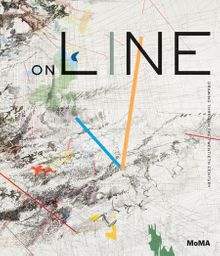 On Line: Drawing Through the Twentieth Century
On Line: Drawing Through the Twentieth Century
Published by The Museum of Modern Art, New York.
Edited by Catherine de Zegher, Cornelia H. Butler.
PUBLISHER
The Museum of Modern Art, New York
BOOK FORMAT
Hardcover, 9 x 10.5 in. / 216 pgs / 230 color.
PUBLISHING STATUS
Pub Date 12/31/2010
Out of stock indefinitely
DISTRIBUTION
D.A.P. Exclusive
Catalog: FALL 2010 p. 16
PRODUCT DETAILS
ISBN 9780870707827 TRADE
List Price: $50.00 CAD $60.00
AVAILABILITY
Not available
STATUS: Out of stock indefinitely. |
 Greater New York 2010
Greater New York 2010
Published by MoMA PS1.
Text by Klaus Biesenbach, Cornelia H. Butler, Neville Wakefield.
PUBLISHER
MoMA PS1
BOOK FORMAT
Paperback, 6.25 x 9 in. / 250 pgs / illustrated throughout.
PUBLISHING STATUS
Pub Date 10/31/2010
Out of print
DISTRIBUTION
D.A.P. Exclusive
Catalog: FALL 2010 p. 117
PRODUCT DETAILS
ISBN 9780984177622 TRADE
List Price: $19.00 CAD $25.00
AVAILABILITY
Not available
STATUS: Out of print | 00/00/00 For assistance locating a copy, please see our list of recommended out of print specialists |
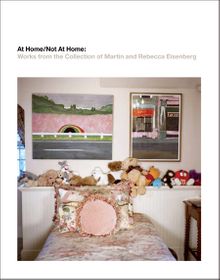 At Home/Not at Home
At Home/Not at Home
Works from the Collection of Martin and Rebecca Eisenberg
Published by Center for Curatorial Studies, Bard College.
Foreword by Tom Eccles. Text by Matthew Higgs, Bob Nickas, et al.
PUBLISHER
Center for Curatorial Studies, Bard College
BOOK FORMAT
Clth, 9.75 x 12.25 in. / 168 pgs / 150 color.
PUBLISHING STATUS
Pub Date 7/31/2010
Out of print
DISTRIBUTION
D.A.P. Exclusive
Catalog: FALL 2010 p. 108
PRODUCT DETAILS
ISBN 9781936192076 TRADE
List Price: $40.00 CAD $50.00
AVAILABILITY
Not available
STATUS: Out of print | 00/00/00 For assistance locating a copy, please see our list of recommended out of print specialists |
 Modern Women: Women Artists at The Museum of Modern Art
Modern Women: Women Artists at The Museum of Modern Art
Published by The Museum of Modern Art, New York.
Edited by Cornelia Butler, Alexandra Schwartz. Introductions by Cornelia Butler, Griselda Pollock, Aruna D'Souza.
PUBLISHER
The Museum of Modern Art, New York
BOOK FORMAT
Hardcover, 9 x 10.5 in. / 512 pgs / 400 color.
PUBLISHING STATUS
Pub Date 6/30/2010
Out of stock indefinitely
DISTRIBUTION
D.A.P. Exclusive
Catalog: SPRING 2010 p. 74
PRODUCT DETAILS
ISBN 9780870707711 TRADE
List Price: $65.00 CAD $87.00
AVAILABILITY
Not available
STATUS: Out of stock indefinitely. |
 Paul Sietsema: Figure 3
Paul Sietsema: Figure 3
Published by The Museum of Modern Art, New York.
Text by Connie Butler.
PUBLISHER
The Museum of Modern Art, New York
BOOK FORMAT
Paperback, 8 x 10 in. / 80 pgs / 55 color.
PUBLISHING STATUS
Pub Date 11/12/2009
Active
DISTRIBUTION
D.A.P. Exclusive
Catalog: FALL 2009 p. 85
PRODUCT DETAILS
ISBN 9780870707766 TRADE
List Price: $29.95 CAD $39.95
AVAILABILITY
In stock
in stock $29.95 Free Shipping UPS GROUND IN THE CONTINENTAL U.S. |
 The Judith Rothschild Foundation Contemporary Drawings Collection Boxed Set
The Judith Rothschild Foundation Contemporary Drawings Collection Boxed Set
Published by The Museum of Modern Art, New York.
Edited by Christian Rattemeyer. Text by Connie Butler, Gary Garrels, Scott Gerson, Isabelle Graw, Martin Herbert, Manfred Hermes, Harvey S. Shipley Miller, Christian Rattemeyer, Brian Sholis, Jan Tumlir..
D.A.P. is pleased to offer two extraordinary volumes dedicated to this extraordinary collection--published to accompany a major exhibition--as well as this boxed set that includes both. Reminiscent of the classic 2002 MoMA catalogue Drawing Now the first of these volumes, Compass in Hand, brings together approximately 250 representative works. The second, The Judith Rothschild Collection of Contemporary Drawings, is a complete catalogue raisonné.
PUBLISHER
The Museum of Modern Art, New York
BOOK FORMAT
Slipcased 2 Volume Hardcover, 9 x 12 in. / 616 pgs / 400 color / 845 bw.
PUBLISHING STATUS
Pub Date 7/31/2009
Active
DISTRIBUTION
D.A.P. Exclusive
Catalog: SPRING 2009 p. 25
PRODUCT DETAILS
ISBN 9780870707650 TRADE
List Price: $120.00 CAD $160.00
AVAILABILITY
In stock
in stock $120.00 Free Shipping UPS GROUND IN THE CONTINENTAL U.S. |
 Compass in Hand: Assessing Drawing Now
Compass in Hand: Assessing Drawing Now
Selections from The Judith Rothschild Foundation Contemporary Drawings Collection
Published by The Museum of Modern Art, New York.
Edited by Christian Rattemeyer. Text by Gary Garrels, Christian Rattemeyer, Harvey S. Shipley Miller.
PUBLISHER
The Museum of Modern Art, New York
BOOK FORMAT
Hardcover, 9 x 11.25 in. / 320 pgs / 320 color / 845 bw.
PUBLISHING STATUS
Pub Date 5/1/2009
Active
DISTRIBUTION
D.A.P. Exclusive
Catalog: SPRING 2009 p. 25
PRODUCT DETAILS
ISBN 9780870707452 TRADE
List Price: $65.00 CAD $87.00
AVAILABILITY
In stock
in stock $65.00 Free Shipping UPS GROUND IN THE CONTINENTAL U.S. |
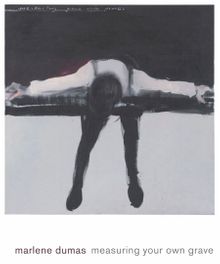 Marlene Dumas: Measuring Your Own Grave
Marlene Dumas: Measuring Your Own Grave
Published by D.A.P./Museum of Contemporary Art, Los Angeles.
Edited by Lisa Gabrielle Mark. Text by Cornelia H. Butler, Richard Shiff, Matthew Monahan, Lisa Gabrielle Mark.
Accompanying Dumas' first major mid-career survey in the U.S., with stops in three major American cities, (one yet to be announced) this substantial, fully-illustrated publication features a newly commissioned essay by renowned scholar Richard Shiff, placing the artist's work in relation to both American figurative painting since the 1980s and Abstract Expressionism. The book also includes curator Cornelia H. Butler's examination of Dumas' photographic sources and shorter texts by Lisa Gabrielle Mark and Matthew Monahan. Writings by the artist, as well as an extensive illustrated exhibition history and bibliography, complete this comprehensive examination of the work of one of the most thought-provoking artists working today.
Born in Capetown, South Africa, in 1953, Marlene Dumas has lived in Amsterdam since 1976. Over the last three decades she has had numerous solo exhibitions throughout Europe and the U.S., including the Tate Gallery, London; the Institute of Contemporary Art, Boston; and the Centre Georges Pompidou, Paris. In 1995 she represented The Netherlands at the 46th Venice Biennale.
PUBLISHER
D.A.P./Museum of Contemporary Art, Los Angeles
BOOK FORMAT
Hardback, 9.75 x 12 / 288 pgs / 200 color / 50 bw.
PUBLISHING STATUS
Pub Date 6/1/2008
Out of print
DISTRIBUTION
D.A.P. Exclusive
Catalog: SPRING 2008 p. 176
PRODUCT DETAILS
ISBN 9781933751085 TRADE
List Price: $55.00 CAD $65.00
AVAILABILITY
Not available
STATUS: Out of print | 00/00/00 For assistance locating a copy, please see our list of recommended out of print specialists |
 Flight Patterns
Flight Patterns
Published by The Museum of Contemporary Art, Los Angeles.
Contributors include Cornelia H. Butler, Lee Weng Choy, Francis Pound.
PUBLISHER
The Museum of Contemporary Art, Los Angeles
BOOK FORMAT
Hardcover, 8.25 x 10 in. / 160 pgs / 160 color / 25 duotone.
PUBLISHING STATUS
Pub Date 10/2/2000
Out of print
DISTRIBUTION
D.A.P. Exclusive
Catalog: SPRING 2001
PRODUCT DETAILS
ISBN 9780914357766 TRADE
List Price: $39.95 CAD $50.00
AVAILABILITY
Not available
STATUS: Out of print | 11/25/2008 For assistance locating a copy, please see our list of recommended out of print specialists |
 The Art Of Richard Tuttle
The Art Of Richard Tuttle
Published by D.A.P./San Francisco Museum of Modern Art.
Edited by Madeleine Grynsztejn. Essays by Madeleine Grynsztejn, Cornelia Butler, Richard Shiff, Katy Siegel, and Robert Storr. Texts by Tara McDowell, Elizabeth Smith, Adam D. Weinberg and Charles Wylie.
The Art of Richard Tuttle is published in conjunction with a major retrospective organized by the San Francisco Museum of Modern Art. The exhibition travels to the Whitney Museum of American Art, New York; the Des Moines Art Center; the Dallas Museum of Art; the Museum of Contemporary Art, Chicago; and the Museum of Contemporary Art, Los Angeles.
PUBLISHER
D.A.P./San Francisco Museum of Modern Art
BOOK FORMAT
Clothbound, 11 x 12 in. / 392 pgs / 265 color / 45 bw.
PUBLISHING STATUS
Pub Date 7/15/2005
Out of print
DISTRIBUTION
D.A.P. Exclusive
Catalog: SPRING 2005 p. 33
PRODUCT DETAILS
ISBN 9781933045009 TRADE
List Price: $65.00 CAD $75.00
AVAILABILITY
Not available
STATUS: Out of print | 00/00/00 For assistance locating a copy, please see our list of recommended out of print specialists |
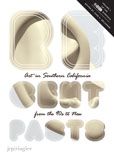 Recent Pasts: Art In Southern California From The 1990S To Now
Recent Pasts: Art In Southern California From The 1990S To Now
Published by JRP|Ringier.
Edited by John C. Welchman. Essays by Connie Butler, Brian Butler, Matthew Coolidge, Dennis Cooper, Mike Davis, Dave Muller, Diana Thater and Frances Stark.
PUBLISHER
JRP|Ringier
BOOK FORMAT
Paperback, 6.75 x 9.5 in. / 160 pgs / 20 bw.
PUBLISHING STATUS
Pub Date 8/15/2005
Out of print
DISTRIBUTION
D.A.P. Exclusive
Catalog: FALL 2005 p. 160
PRODUCT DETAILS
ISBN 9783905701203 TRADE
List Price: $25.00 CAD $34.50
AVAILABILITY
Not available
STATUS: Out of print | 00/00/00 For assistance locating a copy, please see our list of recommended out of print specialists |
